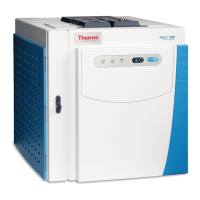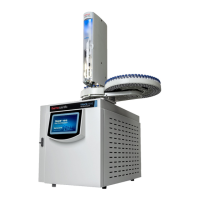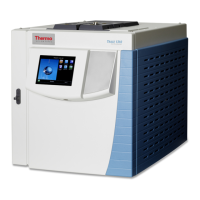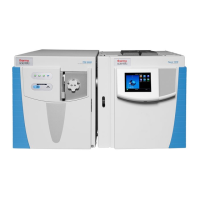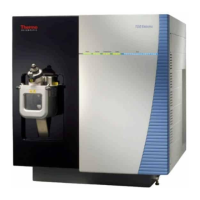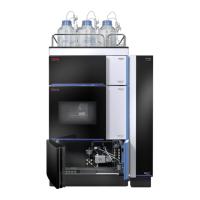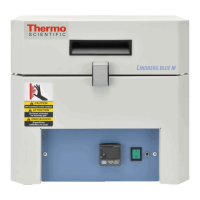Do you have a question about the Thermo Scientific TriPlus RSH and is the answer not in the manual?
Lists safety compliance standards for the device.
Lists EMC compliance standards for the device.
Refers to the laser class for the barcode reader.
Provides an overview of the TriPlus RSH system's fundamental features and advantages.
Details terminology, naming conventions, and icons used within the manual.
Describes the integrated sampling system, its axes, and major components.
Overviews the various configurations applicable to GC techniques.
Explains the primary structure of the sampling unit components and axes.
Describes the Z-axis of the system, injection device, and related components.
Details the intelligence, identification, and attributes of tools used in the RSH system.
Explains the tool used for liquid or gaseous sample injection and its compatibility.
Explains the tool used for headspace injection and its temperature control.
Describes dedicated devices for SPME technique with different fiber lengths.
Explains the tool for In-tube extraction technique and its operational cycle.
Details the components on the back of the crossrail X, including status LEDs and connectors.
Defines active and passive hardware modules and their characteristics.
Lists various modules with their descriptions and specifications.
Provides step-by-step instructions on how to start the TriPlus RSH system.
Explains the different access levels for firmware operation and user friendliness.
Describes the normal working level recommended for routine use.
Provides more possibilities for experienced operators for fine-tuning.
Reserved for qualified service engineers for installation or major repairs.
Details options within Setup, Installation, and Maintenance menus described in chapters.
Explains the rudimentary Handheld Controller functions and navigation.
Displays installed software versions and system information.
Allows controlled shutdown of the TriPlus RSH system.
Explains operation with Thermo Scientific Chromatography Data Systems (CDS).
Details how to access and use the Setup function from the Options menu.
Lists all installed active and passive modules for configuration and setup.
Explains how to adjust the system's date and time settings.
Describes how to assign a unique name for system identification.
Guides through enabling network communication and configuring network settings.
Accesses calibration, teaching, backup, and restore functions for system maintenance.
Accesses the Calibration Wizard for tool calibration without leaving the menu.
Moves the RSH Head through modules for teaching position verification.
Checks system configuration for mismatches and retrieves pending messages.
Resets RSH Firmware configuration to a standard application package.
Extracts essential status information for troubleshooting and saves it encrypted.
Creates a backup file of the current system configuration.
Copies backup files from SD card to USB stick for safe storage.
Loads a backup file (*.pack) back to the system.
Allows importing customized templates for various system items.
Contains installation and tray system creation wizards accessible in Extended User Level.
Guides through the initial setup and configuration of the TriPlus RSH.
Defines a combined system of Tray Holder, Tray Type, and Vial Type.
Optimizes the head's standby position for convenience and efficiency.
Provides troubleshooting guidelines for general chromatographic effects.
Offers troubleshooting guidelines specific to Headspace technique.
Lists safety compliance standards for the device.
Lists EMC compliance standards for the device.
Refers to the laser class for the barcode reader.
Provides an overview of the TriPlus RSH system's fundamental features and advantages.
Details terminology, naming conventions, and icons used within the manual.
Describes the integrated sampling system, its axes, and major components.
Overviews the various configurations applicable to GC techniques.
Explains the primary structure of the sampling unit components and axes.
Describes the Z-axis of the system, injection device, and related components.
Details the intelligence, identification, and attributes of tools used in the RSH system.
Explains the tool used for liquid or gaseous sample injection and its compatibility.
Explains the tool used for headspace injection and its temperature control.
Describes dedicated devices for SPME technique with different fiber lengths.
Explains the tool for In-tube extraction technique and its operational cycle.
Details the components on the back of the crossrail X, including status LEDs and connectors.
Defines active and passive hardware modules and their characteristics.
Lists various modules with their descriptions and specifications.
Provides step-by-step instructions on how to start the TriPlus RSH system.
Explains the different access levels for firmware operation and user friendliness.
Describes the normal working level recommended for routine use.
Provides more possibilities for experienced operators for fine-tuning.
Reserved for qualified service engineers for installation or major repairs.
Details options within Setup, Installation, and Maintenance menus described in chapters.
Explains the rudimentary Handheld Controller functions and navigation.
Displays installed software versions and system information.
Allows controlled shutdown of the TriPlus RSH system.
Explains operation with Thermo Scientific Chromatography Data Systems (CDS).
Details how to access and use the Setup function from the Options menu.
Lists all installed active and passive modules for configuration and setup.
Explains how to adjust the system's date and time settings.
Describes how to assign a unique name for system identification.
Guides through enabling network communication and configuring network settings.
Accesses calibration, teaching, backup, and restore functions for system maintenance.
Accesses the Calibration Wizard for tool calibration without leaving the menu.
Moves the RSH Head through modules for teaching position verification.
Checks system configuration for mismatches and retrieves pending messages.
Resets RSH Firmware configuration to a standard application package.
Extracts essential status information for troubleshooting and saves it encrypted.
Creates a backup file of the current system configuration.
Copies backup files from SD card to USB stick for safe storage.
Loads a backup file (*.pack) back to the system.
Allows importing customized templates for various system items.
Contains installation and tray system creation wizards accessible in Extended User Level.
Guides through the initial setup and configuration of the TriPlus RSH.
Defines a combined system of Tray Holder, Tray Type, and Vial Type.
Optimizes the head's standby position for convenience and efficiency.
Provides troubleshooting guidelines for general chromatographic effects.
Offers troubleshooting guidelines specific to Headspace technique.
| Type | Robotic Sample Handling System |
|---|---|
| Injection Techniques | Liquid, Headspace, SPME |
| Automation | Fully Automated |
| Power Requirements | 100-240 V, 50/60 Hz |
| Application | GC, GC-MS sample preparation and injection |
| Injection Volume | 0.1 µL to 50 µL |
| Temperature Range | 4 °C to 40°C |
| Connectivity | Ethernet |
| Compatibility | Most GC and GC-MS systems |
| Weight | Approx. 30 kg |
| Agitation | Variable speed agitation for sample homogenization |
